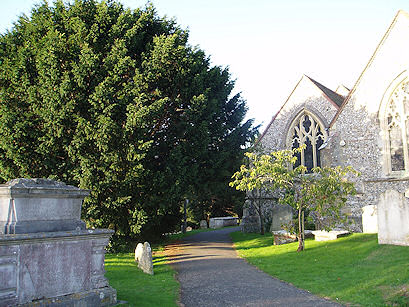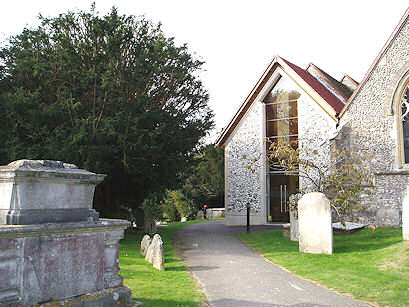

The trees in question are the two Yew trees at the car park end (i.e. the eastern end) of St. Margaret’s Church. As seen from the car park, the tree to the left of the church is referred to as the "southeast tree" and the tree to the right as the "northeast tree".
Repeated assurances were given, prior to and during the construction work, that no trees would be affected by the church extension. However, when the building work was completed, the Church gave notice of intention to carry out work on the trees to reduce the crown by one third.
Arun District Council carried out an assessment of the trees and concluded that “the trees do not make a significant contribution to public visual amenity and therefore it is not considered appropriate that the trees be made the subject of a Tree Preservation Order (TPO) and that no objection be raised to the works proposed.” (Ref: Planning Application No. A/138/08/TC)
They agreed to the extent of the crown reduction in order to “promote new healthy growth.”
The Southeast Tree
The pictures below show the tree before and after the church extension and tree crown reduction.
 |
 |
|
Clearly the tree before crown reduction was quite healthy with extensive, luxuriant, healthy growth |
||
One good thing which emerged from this work is that the clearance of ivy and other vegetation from around the tree revealed a huge trunk with a girth measured at 5.9 metres.
 |
|
To give this some idea of scale - it would take three adults plus one young child |
The tree has now been examined by Dr Owen Johnson, a tree recorder for the Tree Register of the British Isles and for the Ancient Yew Group. He is also the author of the Collins Tree Guide and of the Sussex Tree Book, and has extensive experience in dating ancient trees - particularly Yews.
Dr. Johnson dated the tree as being at least 500 years old and possibly more! As a consequence the tree has been added to the Tree Register as a Notable Tree and has been entered on the Ancient and Veteran Yew National Gazetteer.
There are only two other Yew trees in Arun District appearing on this Gazetteer - one at Aldingbourne (5.5 mtr girth) and one at Walberton (5.8 mtr girth). So Angmering has the largest (5.9 mtr girth) and possibly the oldest recorded Yew tree in Arun District.
Details of the entry can be viewed at www.ancient-yew.org where it is also possible to read expert advice on the care of Yew trees of this age stating that reducing the crown and removing most of the healthy growth is not recommended.
This is the oldest, most significant tree in Angmering and is of National importance.
The Northeast Tree
The work on this tree was a lot less than on the southeast tree largely because the tree surgeon who carried out the work was concerned that this crown had much less luxuriant growth than the other one, probably because the tree was still recovering from a previous crown reduction.
The tree is younger than the southeast tree and with a girth measurement of 3.8 meters (two adults plus a very young child!) it was dated by Dr. Johnson as 150 to 180 years old. It has also been added to the Tree Register as a Notable Tree.
Assessing Amenity Value
The Council Tree Officer dated the trees as 100+ years when in fact they have now been officially recorded as 150+ years and 500+ years.
The District Council assessment decision deals only with public visual amenity stating that the trees can be viewed from the public highway but makes no mention of the fact that they are also fully visible from the approach to the public library opposite, from the adjacent public recreation ground, from the adjoining car park and at close quarters from the footpaths passing directly past the trees.
Because visual amenity can be subjective, the District Council is also required to take further criteria into account in assessing amenity value including:
| Future potential as an amenity? |
|
|
| Veteran tree? |
|
|
| Rarity? |
|
|
| Suitable setting? |
|
|
| Commemorative? |
|
|
| Conservation Area? |
|
The District Council assessment decision makes no reference to any of these further criteria.
The District Council have now been supplied with complete, accurate information regarding these two important trees showing how all required aspects of amenity value are satisfied and they have been asked to take a fresh look at the question of whether these trees should now be made the subject of a TPO.
Please take a few moments next time you are passing to have a look at these trees. Do not worry about the southeast tree having a lot of dead wood and splits in the trunk – this is quite normal for a Yew of this age. In fact many perfectly healthy ancient Yews have a completely hollow trunk and lots of dead wood - an ideal wildlife habitat.
If you feel that these trees should be given the protection of a Tree Preservation Order (TPO) please write to the Head of Development Control, Arun District Council, Civic Centre, Maltravers Road, Littlehampton BN17 5LF, expressing your support for this request.
Mike Pearn
(October 2009)